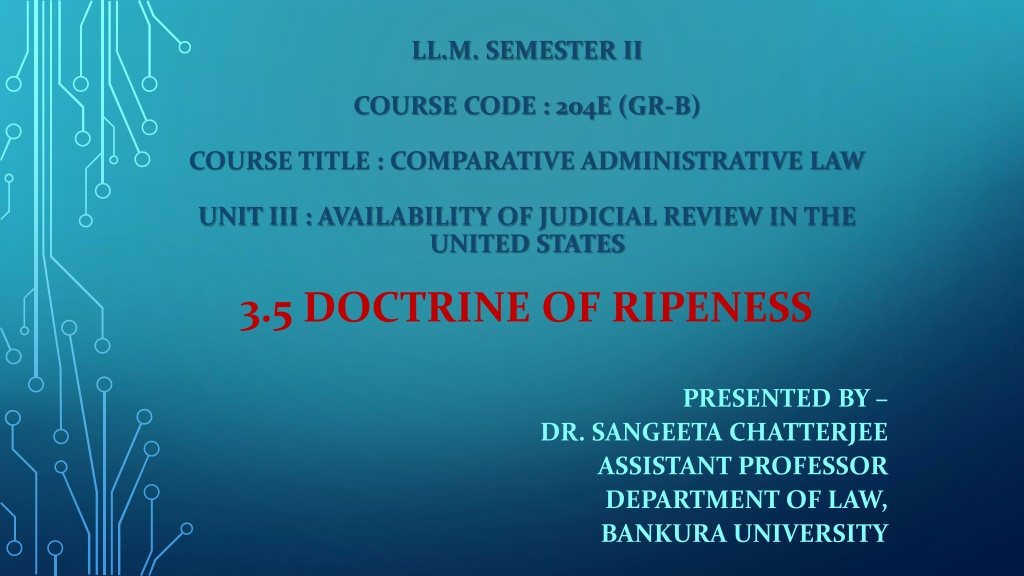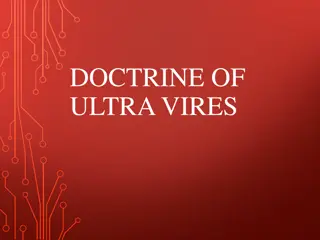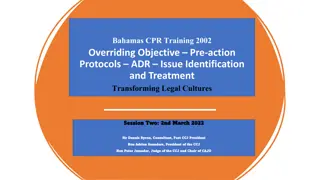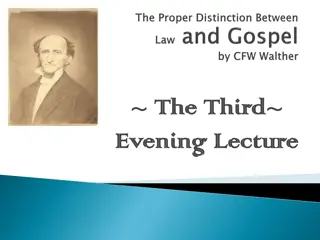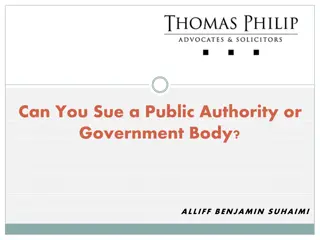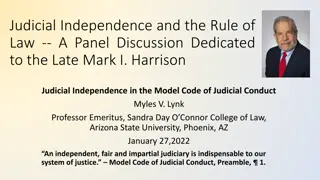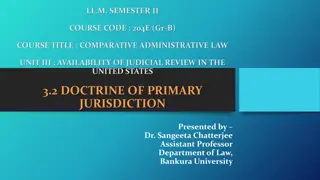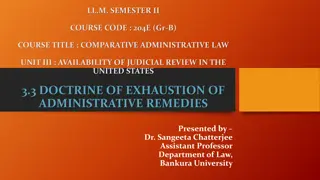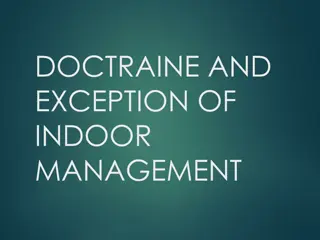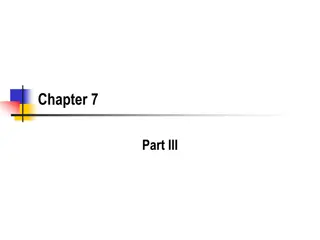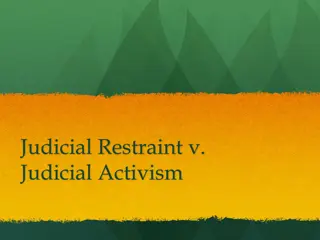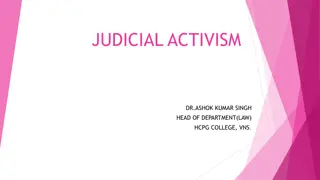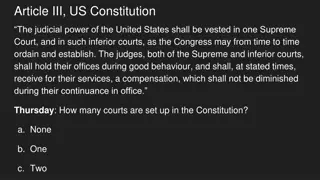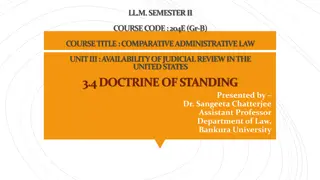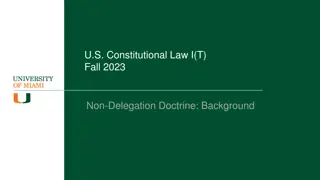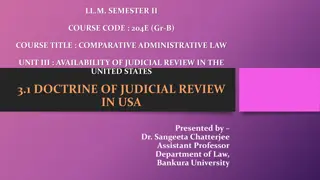Understanding the Doctrine of Ripeness in Judicial Review
The doctrine of ripeness in judicial review focuses on the timing of court intervention, ensuring that cases are mature enough for adjudication. It aims to prevent premature decisions and conflicts with other branches of government, emphasizing the need for cases to be fit for judicial review before court consideration. The fitness of issues and hardship to parties are key factors in determining ripeness, with a two-part test established by the Supreme Court.
Download Presentation

Please find below an Image/Link to download the presentation.
The content on the website is provided AS IS for your information and personal use only. It may not be sold, licensed, or shared on other websites without obtaining consent from the author. Download presentation by click this link. If you encounter any issues during the download, it is possible that the publisher has removed the file from their server.
E N D
Presentation Transcript
LL.M. SEMESTER II COURSE CODE : 204E (GR-B) COURSE TITLE : COMPARATIVE ADMINISTRATIVE LAW UNIT III : AVAILABILITY OF JUDICIAL REVIEW IN THE UNITED STATES 3.5 DOCTRINE OF RIPENESS PRESENTED BY DR. SANGEETA CHATTERJEE ASSISTANT PROFESSOR DEPARTMENT OF LAW, BANKURA UNIVERSITY
INTRODUCTION Ripeness is a doctrine that relates to the timing of judicial review, asking if the court is equipped to adjudicate the issues before it. The basic rationale of the ripeness doctrine is "to prevent courts, through avoidance of premature adjudication, from entangling themselves in abstract disagreements policies, and over administrative Also to protect the agencies from judicial interference until an administrative decision has been formalized and its effects felt in a concreteway by the challenging parties.
DOCTRINE OF RIPENESS The doctrine of ripeness mainly determines the fitness of the case for judicial review. Ripeness means the maturity of a case to be taken up by the court for judicial review. Unless and until a case is fit for judicial review, it is not taken up by the court and it reverts back to the concerned administrative authority for further hearing. Ripeness is the criteria fordetermining the fitness of thecase in this respect. Doctrine of ripeness is purely creation of the US judiciary and not a product of the US Constitution. Though Article III of the US Constitution recognizes doctrine of ripeness, but it is not expressly mentioned anywhere in the US Constitution.
BASIC RATIONALE OF THE DOCTRINE The unproblematic. The "basic rationale" of the ripeness requirement is "to prevent courts, through the avoidance of premature adjudication, from entangling themselves in abstract disagreements" with otherorgans of government. central principles of the ripeness doctrine are
TWO-PART RIPENESS TEST In Abbott Laboratories v. Gardner, still characterized as the "leading discussion" of the doctrine, the Supreme Court developed a two-part ripeness test. The first step involved an evaluation of "the fitness of the issues for judicial decision" and The second, "the hardship to the parties of withholding court consideration.''
FACTORS DETERMINING FITNESS ISSUE Courts evaluate several factors in determining whether the fitness requirement of the test is met. One is that the issues involved should be legal ones. Another is whether the agency action at issue constitutes "final agency action" as mandated under the Administrative Procedure Act ("APA"). This concept of final agency action is often referred to as finality. Indeed, it has been suggested that finality may be the key element in determining not only fitness, but ripeness as a whole. The hardship aspect of the ripeness test focuses on the practical effects of the agency action and essentially involves a balancing of the interests involved.
ORIGIN OF THE DOCTRINE Abbott Laboratories v. Gardner, 1967, generally regarded as the beginning of the modern ripeness era. Abbott Labs involved a challenge bydrug manufacturers to Food and Drug Administration regulations that imposed labeling requirements on prescription for drug packaging and advertising. The Supreme Court formulated the two-part test for determining ripeness and, after applying that test, concluded that the claim was ripe for review. Emphasizing that "finality" was to be interpreted in a pragmatic way, the Court determined that the regulations constituted final agency action as required under the APA because they were formally promulgated, were effective upon publication, were authorized directly bythe statute, and had the status of law.
ADVANTAGES OF THE DOCTRINE First, the ripeness doctrine has perhaps most frequently been used to measure the demands of substantive statutory or constitutional causes of action. Second, ripeness review often has been employed to determine whether the litigant's asserted harm is real and concrete rather than speculative and conjectural. Third, the ripeness requirement has been used to serve the goals of prudent judicial decision making.
THE RIPENESS DOCTRINE AND FIRST AMENDMENT FREEDOM OF SPEECH Courts have been readily willing to find First Amendment freedom of speech issues ripe for review. Courts believe that freedom of speech is more worthy of judicial review and protection than other constitutional rights. First Amendment rights of free expression and association are particularly apt to be found ripe for immediate protection.
DISTINCTION BETWEEN RIPENESS AND EXHAUSTION Exhaustion of administrative remedies is also related to the doctrine of ripeness. Courts do not review administrative decisions that are not "ripe," that is, not sufficiently finalized to warrant judicial scrutiny. The ripeness issue asks whether an agency has reached a decision or is still deliberating. The exhaustion issue asks whether a plaintiff has used all procedures at the agency level to influence the decision. When the unexhausted administrative action is an administrative appeal, exhaustion is clearly distinguishable from ripeness. The agency has reached a decision, but could reverse it. When the unexhausted agency action is a variance proceeding, the line between the two doctrines blurs. The agency has reached a decision by promulgating a general regulation.
CONCLUSION It is easy to conclude, with Professor Davis, that the approach of Abbott Laboratories provides an "excellent foundation" for the analysis of ripeness issues. Its open inquiry avoids both the rigidity of prior ripeness law and the questionable systems of classification that characterize other justiciability doctrines.
REFERENCE : 1. Eacata Desiree Gregory, No Time Is the Right Time: The Supreme Court's Use of Ripeness to Block Judicial Review of Forrest Plans for Environmental Plaintiff 's in Ohio Forestry Ass'n v. Sierra Club, Chicago- Kent Law Review, Vol. 75 (2), 2000, https://scholarship.kentlaw.iit.edu/cklawreview/vol75/iss2/14, visited on 27.05.2020. 2. Gene R. Nichol, Jr, Ripeness and the Constitution, The University of Chicago Law Review, Vol. 54, 1987. 3. Timothy V. Kassouni, The Ripeness Doctrine and the Judicial Relegation of Constitutionally Protected Property Rights, California Western Law Review, Vol. 29 (1), 1992, https://scholarlycommons.law.cwsl.edu/cwlr/vol29/iss1/2, visited on 27.05.2020.
